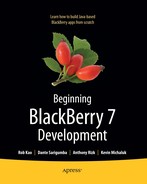Contents
What You Need to Know Before You Can Begin
Setting Up Your Development Environment
Installing the Development Environment
What’s Different About Developing for BlackBerry
Creating an Application with the BlackBerry JDE Plug-In for Eclipse
Creating the Application Classes
Building with Different JDE Versions
Packaging and Signing Your Application
Setting the Title in the BlackBerry Application Descriptor
![]() Chapter 3: What Makes a BlackBerry Application?
Chapter 3: What Makes a BlackBerry Application?
The BlackBerry Application Life Cycle
Threading and the Event Thread
Knowing When Your Application Is on the Event Thread
Updating the UI from Other Threads
Running Background Applications
Detecting Backgrounding or Foregrounding
Sending Your Application to the Background
Understanding the Types of Projects
Creating an Alternate Entry Point
![]() Chapter 4: User Interface Basics
Chapter 4: User Interface Basics
The Components of a BlackBerry UI
Implementing the Login and Clear Menu Items
![]() Chapter 5: Beyond the Basics of User Interfaces
Chapter 5: Beyond the Basics of User Interfaces
Enhancing the UI Fun Application
Drawing to the Screen Using the Graphics Context
Understanding How the BlackBerry Screen Is Drawn
Creating a Custom Button Field
Tidying Up the Login Success Screen
Implementing the Screen’s Sublayout Method
Working with Touch Screen Models
![]() Chapter 6: Storing and Searching Data
Chapter 6: Storing and Searching Data
Storing Data on the BlackBerry
Clearing Persistent Data from a Device
Listing the Directory Contents
Loading Images from the File System
Getting Images into the Simulator
Creating a Database and a Table
Integrating Your App with Unified Search
![]() Chapter 7: Hello Out There! Making a Network-Enabled Application
Chapter 7: Hello Out There! Making a Network-Enabled Application
The HttpRequestDispatcher Class
Two-Way Interaction: Sending Data via HTTP POST
Connection Method: Using Direct TCP/IP Instead of BES/MDS
Making a Connection Using WAP 2.0
Determining Network Availability
![]() Chapter 8: Where Am I? Using Location-Based Services
Chapter 8: Where Am I? Using Location-Based Services
GPS Support on BlackBerry Devices
Getting Location Information Using JSR 179 APIs and the BlackBerry Extensions to JSR 179
Specifying a GPS Mode Using JSR 179
Specifying a GPS Mode Using the BlackBerry Extensions to JSR 179
Getting Periodic Location Updates Using LocationListener
Using Geocoding and Reverse Geocoding
Geocoding: Getting Coordinates from an Address
Launching the Default BlackBerry Maps View
MapField: Embedding BlackBerry Maps in Your UI
![]() Chapter 9: Getting Your App Out There: Packaging and Publishing
Chapter 9: Getting Your App Out There: Packaging and Publishing
Setting Application Properties
Distributing Your Application on App World
